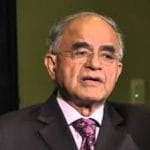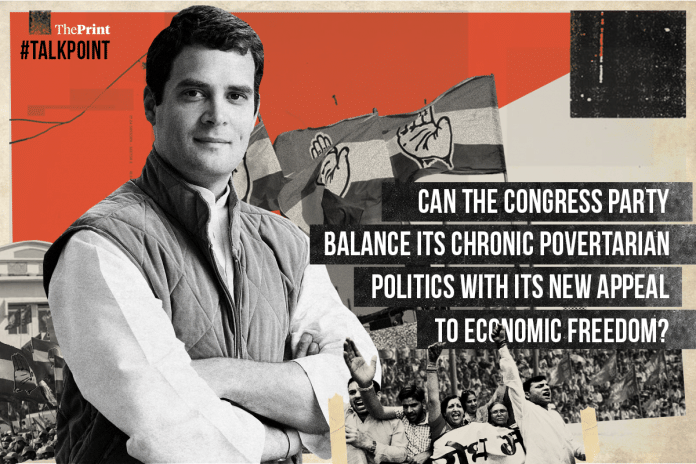The Congress party, in its recent economic resolution, stated that “the Modi government has unleashed economic oppression, harassing entrepreneurs with tax terrorism, motivated litigation, veiled threats, demonetisation and an ill-conceived GST”. The party also resolved to win back “economic freedom for India’s entrepreneurs, especially MSMEs”.
ThePrint asks: Can the Congress party balance its chronic povertarian politics with its new appeal to economic freedom?
It’s not povertarian politics, the Congress believes in inclusive economic growth
 M.V. Rajeev Gowda
M.V. Rajeev Gowda
Member of Parliament, Congress, Rajya Sabha
I reject the term “chronic povertarian politics”.
The Congress has always adapted to the zeitgeist. According to economist Pulapre Balakrishnan in ‘Economic Growth in India’, newly Independent India required a mixed economy guided by strategic planning to drive a ‘big push’ to modernise Indian industry, after the havoc wrought by British colonialism.
The liberalisation of the ’80s and ’90s not only ushered in the telecom and information technology revolution in India, but also created unprecedented wealth. In contrast, the NDA’s ‘India Shining’ showed that trickle-down economics, with wealth concentrated in the top 5 per cent, does not work in India.
The UPA government (2004-14) combined record private sector-led economic growth with a strong welfare state model. We passed several rights-based legislations to ensure the protection of the economic, civil, social and political rights of Indians, particularly those who belong to vulnerable groups and communities. The rights-based paradigm and safety net ensured that every Indian shared in our nation’s wealth, building on our constitutional commitment to fraternity and equality of opportunity.
The record speaks for itself. The UPA delivered an average 7.7 per cent GDP growth annually over a 10-year period. Rural wages tripled. Nearly 140 million people were lifted out of poverty. Per capita income increased three times at an annual average of 20 per cent, well over the consumer price index. Social harmony was largely maintained and inequality reduced.
We have seen a reversal of this during the Modi regime. Demonetisation and the hasty implementation of the GST has unleashed havoc on MSMEs and the informal sector. Labour-intensive sectors like leather, textiles and construction have been throttled. Economic growth slowed down by 1-2 per cent, meaning the loss of Rs. 1.5 to 3 lakh crore of wealth, and the shattering of lakhs of livelihoods and aspirations.
The Congress remains committed to the fundamentals of the economic resolution passed at the 84th AICC plenary. It states, “The Congress party believes in the twin goals of inclusive economic growth through private enterprise, a competitive and viable public sector, and a robust social safety net through a strong welfare state.” As P. Chidambaram asserted, “We have done it before, we’ll do it again.”
Modi failed to provide high growth, but Congress’ ability to succeed is more suspect
 Gurcharan Das
Gurcharan Das
Former CEO, Procter and Gamble, India
I am disappointed with Narendra Modi’s lack of success in achieving high growth and the jobs that he had promised, but I am even more sceptical about the Congress’s ability to do so. Its talk of helping entrepreneurs is hollow. Under UPA-II, it made a false trade-off between growth and equity, and brought a rapidly growing economy down to its knees, from a growth rate of 8.5 per cent to 4.5 per cent. During UPA-I, India was growing rapidly, harvesting the fruits of the 1991 reforms. But there were many Congress leaders who either took growth for granted or were embarrassed by it, calling it “jobless growth”.
To maintain high growth requires hard work but the UPA-II diverted its attention from infrastructure-building to things like the Food Security Act, which promised food grains at 10 per cent of the market price to almost 70% of the people. It is staggering to imagine that 70 per cent of Indians are below the poverty line and deserving of food subsidy. Infrastructure-building suffered greatly at the hands of the ministry of environment, which almost stopped giving any approvals, and we are still suffering from this through the non-performing assets (NPAs) of these companies.
Concern for the poor is commendable on the part of the Congress but it has still not understood that the best way to help the poor is not through giveaways but through decent jobs, and a good education and healthcare system. The DNA of the Congress is not aspirational, it is povertarian.
There is a complete bankruptcy of ideas, policy initiatives, and vision in the Congress
 Syed Zafar Islam
Syed Zafar Islam
BJP spokesperson and former investment banker
Former Prime Minister Manmohan Singh said Sunday they left the economy in a very good shape. He cannot claim this as an objective economist because he is a national spokesperson of the Congress party.
In 2014, the economy was in an abysmal state. Fiscal deficit, GDP, inflation, joblessness, everything was a mess.
Inflation was in double digits. Now it has come down to 4.5 per cent. People have a positive income. They have money to generate investment. This is all thanks to the BJP’s fiscal prudence. Ease of doing business has improved. Corruption had been reduced and the process of bidding for government projects has become more transparent.
It was the Congress that conceptualised the GST; now they have a problem with it? The objective of both the GST and demonetisation was to formalise the economy. The higher the number of tax payers, the more money the government has. This money can be used to provide services for the poor. MUDRA and MNREGA have consistently gained from the BJP’s policies.
Today, there is a complete bankruptcy of ideas, policy initiatives, and vision in the Congress camp. What they are suggesting, entrepreneur-friendly reforms, contradicts their own earlier stand. All they are trying to do is copy the BJP. They have seen that an alternative approach has been adopted towards governance by the BJP. They can’t help but mimic it.
The BJP is not only focused on entrepreneurs and foreign investors; local investors are very happy with the government as well.
The Congress is a confused party. They are feeling completely isolated because their policies of crony capitalism benefited only a few. They can’t keep up with the challenge of Modinomics that has managed to reach various different sections and strata of society.
Congress has killed any hope that the party has more effective alternatives
 Narendar Pani
Narendar Pani
Economist and professor at the National Institute of Advanced Studies.
By placing the blame for the current economic pressures entirely on the inefficiency of the Narendra Modi government, the Congress party is trying to hide the deficiencies of the economic strategy it forced on the Indian economy. The party may find many takers for its claims about the BJP’s inefficiency, what with the pains of demonetisation and GST. The problem, though, is not one of implementation alone but also of the unsustainable political economy the Congress has been promoting.
At the heart of Congress policies lies a simple dualism: generate growth by whatever means possible, and then pass on a part of the surplus to welfare schemes. But the growth-by-any-means strategy generates costs that welfare measures cannot always paper over.
The Congress resolution has reiterated that it stands for a single GST rate of 18 per cent on the grounds that it will generate efficiency and growth. The fact that those buying a packet of salt should pay the same rate as those buying an Audi may not bother the elite who make economic policy in the Congress, but the unequal burden it places on the poor generates a demand for welfare that the governments are finding increasingly difficult to meet.
And this is by no means the only casualty of the growth-by-any-means strategy. The firm belief that favoured industrialists would generate growth if banks are forced to give them a leg-up has contributed in no small manner to the current NPA crisis. The belief that growth is all that matters, even if it does not create too many jobs, adds to the crisis. In brushing these serious strategic deficiencies under the carpet of the BJP’s inefficiency, the Congress has killed any hope that the party has more effective alternatives.
The Congress should realise gradual, organic change is more suited for a changing India
 Rajesh Chakrabarti
Rajesh Chakrabarti
Professor and vice-dean at the Jindal Global Business School, O.P. Jindal Global University
The observations of the Congress on the current government’s economic performance are far from unfair. Clearly, India is yet to see “achhe Din“, and, indeed, demonetisation and the somewhat premature GST implementation have considerably hurt the unorganised sector, where, by far, most jobs originate. Hence, the impact on jobs — the biggest challenge for India — has not been great. However, the job challenge for India predates the Modi government. Between 2005 and 2012, while the GDP grew at a cumulative 54 per cent, jobs grew at a measly 3%. As Krugman rightly observed, the situation is getting from problematic to crisis rather fast.
Now what can the Congress do differently? The organised sector needs to grow in the medium/long run, but not through overnight measures to stifle the unorganised sector. Gradual, organic change is more suited for a changing India rather than this overactive drive to change the economy by command. Are welfare measures the solution? Not in the long run, but you cannot really push the country, cold turkey, to extreme formalisation. So in the short run, support to farmers and other groups in need has to continue.
Expectation management is another critical step, to keep the population on board while the more gradual structural change occurs. Anti-poverty measures are less at odds with pro-entrepreneurial reforms than is frequently imagined, and structural change through the private sector will inevitably be a slow process.
For any government in power, the task would be an uphill one.
The Congress as a party oscillates in its economic approach and shows little consistency
 Ruhi Tewari
Ruhi Tewari
Associate Editor, ThePrint
The contradiction between the Congress’ liberal and left-leaning economic orientation played out once again at its 84th plenary. In its economic resolution, on the one hand, it recommended imposing a five per cent cess on the super rich, and on the other, it laid a strong focus on the role of the private sector in employment creation, an unequivocal commitment to economic freedom, and even a critique of the state in harassing private entrepreneurs.
Such paradoxes are not uncommon to the party. This was a tension that played out in the Congress-led UPA government between its economic policymakers and the Sonia Gandhi-led National Advisory Council (NAC). This was also a faultline in the Congress government in 1991 with Prime Minister Narasimha Rao and his finance minister Manmohan Singh on one side and the party’s old guard on the other.
The Congress as a party has oscillated in its economic approach, showing little consistency. In the recent past, for instance, while its government ushered in the watershed 1991 economic liberalisation, its 10-year stint at the helm of the UPA from 2004-14 saw barely any focus on economic reform, with an overt emphasis on welfare policies instead. MNREGA, the Food Security Act and the revised Land Acquisition Act were its key social welfare initiatives, while the Vodafone retrospective tax decision was the opposite of economic reform.
In its latest economic resolution, it may have shown a glimmer of appeal to economic freedom, but the party of ‘gareebi hatao’ is hardly one to give up on its brand of politics — appealing to the poor and underprivileged.
These objectives, while often contradictory, are not irreconcilable if planned well. Both growth and welfare are crucial. The former will come from the private sector, entrepreneurship and industry, and the latter from strong government intervention. To be able to run with both, a careful and clever balancing act is what is needed. The Congress, unfortunately, has shown little ability to achieve this very balance.
Rahul knows that attacking businessmen gets him votes, its pure politics
 Kumar Anshuman
Kumar Anshuman
Associate Editor, ThePrint
In 1952, when the first general elections were held, the Congress manifesto clearly stated that the country would have a public sector and a private sector, provided the latter accepts the objective of the national plan and fits into it.
The idea of a mixed economy has always been on the Congress’ agenda, right from the early days. The party always believed industrial development would lead to the overall welfare of people.
At the same time, the party has generously given out government funds for social welfare. In 1971, Indira Gandhi came back to power on the slogan of ‘garibi hatao’, though not much was achieved after she formed the government.
It is only over the past few years that the Congress has moved away from the mixed economy formula and leaned more towards welfare politics. The formation of the national advisory council (NAC) was the first big step and, from there onwards, the UPA government relied more on inclusive growth.
In the later years, Rahul Gandhi took up the farmers’ cause and there was a sudden shift in the party’s approach towards businesses. Businesses were blamed for every wrong policy, and that became a big reason for the business class moving towards Narendra Modi.
In April 2013, Rahul Gandhi’s address at CII was about empowering villages with better infrastructure and how businesses can help in that.
Over a year later, Rahul was protesting against the land acquisition bill brought by the NDA government. He has never minced his words in accusing some industrialists of robbing the country’s wealth with the support of the Modi government.
He knows that attacking businessmen gets him votes. But would alienating them help if he came to power? Through the economic resolution at the Congress plenary, there is a clear indication that the party would go back to the mixed economy formula it has tried several times in the past.
At present, whatever the party is doing is pure politics. Therefore, the question of maintaining a balance is something they would think about only when they come to power, and, for that, they need to talk poverty, unemployment, farmer crisis.
Compiled by Deeksha Bhardwaj, Journalist at ThePrint.







The one genuine reformer the party has is Shri P. Chidambaram. It might wish to task him to start work on a serious blueprint for revival of the economy. If voted back to power at the head of a very large group of regional parties, the Congress will have to move beyond the welfarism of the NAC. Someone like Ms Mamata Banerjee, once seen as being to the left of the Left, is now taking prudent management of state finances and attracting investment to Bengal very seriously. There is growing despair in the countryside. No one will allow a non performing government to sit in peace.
Let’s assume Rahul Gandhi is a dud and is saying whatever he thinks will get his party votes. But I sincerely want to ask the writer: what is your fantastic solution to deal with poverty – which is a very real issue. Running a country is not about textbook theories and isms, and allergies to words like povertarianism. People under poverty line are real human beings. Beyond hoping that big business will hit it big, and somehow the benefits will trickle down to lower sections, does the writer even have a solution? Given neither manufacturing has picked up despite a massive majority for BJP, nor has the government anything to show for lessening of corruption, have you prioritised one section, and will think up something for the rest as you go along? Are you blind to bad loans accumulated by big business or do you believe they re immune from scrutiny? It is not a talking point that Congress is talking abt farmers crisis. It is weary cynicism and privileged ennui of the writer that he talks as if speaking of the farmer crisis – addressing it – is a choice that the country has. Poverty alleviation is not a tulip you pick from a florist to drop into a bouquet, leaving out the carnations. Pity the writer is clueless and utterly unsympathetic to pressing problems. Rahul Gandhi is not even the Prime Minister. Let’s see half this critique of Modi’s policies. He is answerable.